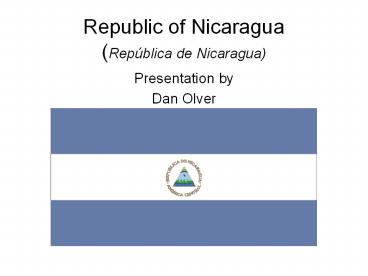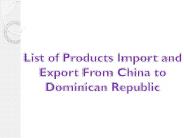Republic of Nicaragua Repblica de Nicaragua - PowerPoint PPT Presentation
1 / 25
Title:
Republic of Nicaragua Repblica de Nicaragua
Description:
Nicaragua's climate varies with altitude and season. ... Nicaragua is one of the hemisphere's poorest countries, faces low per capita ... – PowerPoint PPT presentation
Number of Views:695
Avg rating:3.0/5.0
Title: Republic of Nicaragua Repblica de Nicaragua
1
Republic of Nicaragua(República de Nicaragua)
- Presentation by
- Dan Olver
2
Nicaragua
3
Nicaragua
Location Central America, bordering the Caribbea
n Sea and Pacific Ocean Between Costa Rica and
Honduras 13 00 N, 85 00 W Area Total 129,494
sq km land 120,254 sq km water 9,240 sq km
Slightly smaller than the state of New
York Largest country in Central America larges
t freshwater body in Central America, Lago de
Nicaragu (Lake Nicaragua).
4
Background
- CAPITAL CITY
- Managua
- INDEPENDENCE DAY
- 15 September 1821 (from Spain)
- GOVERNMENT TYPE
- Republic
- HEAD OF STATE
- President Enrique BOLANOS Geyer
- LAND USE
- arable land 15.94 permanent crops 1.94
other 82.12 (2001) - Irrigated land880 sq km (1998 est.)
- NATURAL HAZARDS
- destructive earthquakes, volcanoes, landslides
extremely susceptible to hurricanes
5
Climate
- Nicaraguas climate varies with altitude and
season. The summer, or dry season, from
mid-November to mid-May, is hot and dry, with
cooler nights. Winter, better described as the
rainy season, from mid-May to mid-November, is
hot and humid, with short, heavy tropical showers
that may occur daily, often accompanied by
violent electrical storms. - Streams flood in the rainy season and dry up the
rest of the year. The average daily high
temperature in Managua ranges from 79F to 93F.
Nights are usually temperate. Temperatures in the
mountains can dip as low as 61F, while the east
coast high may be a humid 84F
6
Population
- POPULATION 5,570,129
- Median Age 20.9
- Population Growth 1.89
- Birth Rate 24.51 (per 1000)
- Infant Mortality Rate 28.11
- Life Expectancy at Birth 70.63
- Ethnic Groups Mestizo (mixed Amerindian and
white) 69, white 17, black 9, Amerindian 5 - Religions Roman Catholic 72.9, Evangelical
15.1, Moravian 1.5, Episcopal 0.1, other 1.9,
none 8.5 (1995 census) - Languages Spanish 97.5 (official), Miskito
1.7, other 0.8 (1995 census) - Literacy Rate Total Population 67.5
7
People of Nicaragua
- Most Nicaraguans have both European and Indian
ancestry, and the culture of the country reflects
the Ibero-European and Indian heritage of its
people. - Only the Indians of the eastern half of the
country remain ethnically distinct and retain
tribal customs and languages. - A large black minority, of Jamaican origin, is
concentrated on the Caribbean coast. In the
mid-1980s, the central government divided the
eastern half of the country--the former
department of Zelaya--into two autonomous regions
and granted the people of the region limited
self-rule. - The 1995 constitutional reform guaranteed the
integrity of the regions several unique cultures
and gave the inhabitants a say in the use of the
areas natural resources. Roman - Catholicism is the major religion, but
Evangelical Protestant groups have grown
recently, and there are strong Anglican and
Moravian communities on the Caribbean coast. - Most Nicaraguans live in the Pacific lowlands and
the adjacent interior highlands. The population
is 54 urban.
8
Economy
- Nicaragua is one of the hemisphere's poorest
countries, faces low per capita income, massive
unemployment and underemployment, and huge
external debt. - Distribution of income is one of the most unequal
on the globe. While the country has made progress
toward macroeconomic stability over the past few
years, GDP annual growth of 1.5 - 2.5 has been
far too low to meet the country's needs. - Nicaragua will continue to be dependent on
international aid and debt relief under the
Heavily Indebted Poor Countries (HIPC)
initiative. Nicaragua has undertaken significant
economic reforms that are expected to help the
country qualify for more than 4 billion in debt
relief under HIPC in early 2004.
9
Economy of Nicaragua
10
Economy Overview
- Gross Domestic Product 16,090,000,000
- GDP (per capita) 2,900.00
- CURRENCY Gold Cordoba
- Population below Poverty Line 50 (2001 est.)
- Inflation Rate 9.60
- Labor Force 2,010,000
- Labor Force (by occupation) services 43
agriculture 42 industry 15 - Unemployment Rate 6.90, Underemployment Rate
46.5 - Budget 1,134,000,000
- Industries food processing, chemicals, machinery
and metal products, textiles, clothing, petroleum
refining and distribution, beverages, footwear,
wood - Agriculture Products Coffee, bananas, sugarcane,
cotton, rice, corn, tobacco, sesame, soya, beans
beef, veal, pork, poultry, dairy products
11
Volcanoes
- Western Nicaragua is lined with active volcanoes,
and their frequent eruptions have produced soil
that is among the most fertile in Central
America. The country is also subject to very
severe earthquakes
- Momotombo Volcano
12
History Pre-Colonial
- Two basic culture groups existed in pre-colonial
Nicaragua. The native peoples were linguistically
and culturally similar to the Aztec and the Maya.
Staple foods of both populations were corn,
beans, chili peppers, and avocados, still the
most common foods in Nicaragua today and
chocolate was drank at ceremonies. - Most of Nicaragua's Caribbean lowlands area was
inhabited by tribes that migrated north from what
is now Colombia. - When the Spanish arrived in the early 1500s, they
found three principal tribes, each with a
different culture and language the Niquirano,
the Chorotegano, and the Chontal. Each occupied
much of Nicaragua's territory, with independent
chieftains (cacicazgos) who ruled according to
each group's laws and customs.
13
Colonial History
- Nicaragua's Caribbean coast was first seen by
Spanish explorers in 1508. - Chief Nicoya and Chief Nicaragua or Nicarao,
after whom the country was named received the
Spanish with a warm welcome. - Many converted to Catholicism.
- Francisco Hernández de Córdoba was appointed to
lead the Nicaraguan conquest. In 1524 he quickly
overcame the resistance of the native peoples and
named the land Nicaragua.
14
The Somoza Years
- Somoza García controlled political power,
directly as president or indirectly through
carefully chosen puppet presidents, from 1936
until his assassination in 1956. - Somoza García ruled Nicaragua with a strong arm,
deriving his power from three main sources the
ownership or control of large portions of the
Nicaraguan economy, the military support of the
National Guard, and his acceptance and support
from the United States. His excellent command of
the English language and understanding of United
States culture, combined with a charming
personality and considerable political talent and
resourcefulness, helped Somoza García win many
powerful allies in the United States. - Through large investments in land, manufacturing,
transport, and real estate, he enriched himself
and his close friends. - Succeeded by his sons Luis Somoza Debayle and
Anastasio Somoza Debayle
15
The 1972 Managua Earthquake
- On December 23, 1972, a powerful earthquake shook
Nicaragua, destroying most of the capital city. - The earthquake left approximately 10,000 dead and
some 50,000 families homeless, and destroyed 80
percent of Managua's commercial buildings. - The National Guard joined the widespread looting
of most of the remaining business establishments
in Managua. - The government's illegal appropriation and
mismanagement of international relief aid by the
Somoza family and members of the National Guard,
shocked the international community.
16
The Sandinistas
- Most Nicaraguans saw the Sandinista victory as an
opportunity to create a system free of the
political, social, and economic inequalities of
the hated Somoza regime. - Daniel Ortega began his six-year presidential
term on January 10, 1985. After the United States
Congress turned down continued funding of the
Contras in April 1985, the Reagan administration
ordered a total embargo on United States trade
with Nicaragua
17
The UNO Victory
- As a result of the Esquipulas II peace accords,
the FSLN government reinstated political
freedoms. The Sandinistas felt confident of their
success at the polls despite deteriorating
socioeconomic conditions in the country. - The UNO and the Sandinistas began their political
campaigns in the summer of 1989. Although sharp
divisions within the UNO remained the
anti-Sandinista coalition nominated Violeta
Barrios de Chamorro - The FSLN nominated Daniel Ortega for the
presidency and Sergio Ramírez Mercado as his
running mate. - The political campaign was conducted under the
close international supervision of the OAS, the
UN, and a delegation headed by former United
States President Jimmy Carter. - In the February 25, 1990, elections, Violeta
Barrios de Chamorro carried 55 percent of the
popular vote against Daniel Ortega's 41 percent.
18
Daniel Ortega
- Fifteen years after being voted out of power, and
with two unsuccessful runs for the presidency
since, Daniel Ortega is back - Head of the Marxist Sandinista National
Liberation Front (FSLN) is back with a chance of
returning to power. - Credibility has taken a beating since his
grown-up stepdaughter accused him in 1998 of
abusing and raping her for years. - Also signed a self-serving pact in 1999 with
political rival and former President Arnoldo
Aleman, now serving a 20-year sentence for
embezzlement.
Friend of Hugo
19
Telecommunications
- The Major Phone company is Enitel.
- Telephones - main lines in use 214,500 (2004)
- Telephones - mobile cellular 738,600 (2004)
- Telephone system general assessment inadequate
system being upgraded by foreign investment
domestic low-capacity microwave radio relay and
wire system being expanded connected to Central
American Microwave System international country
code - 505 - satellite earth stations - 1 Intersputnik
(Atlantic Ocean region) and 1 Intelsat (Atlantic
Ocean) - Radio broadcast stations AM 63, FM 32,
shortwave 1 (1998) - Television broadcast stations 3 (plus seven
low-power repeaters) (1997) - Internet country code .ni
- Internet hosts 12,628 (2005)
- Internet users 125,000 (2005)
20
WiMAX in Puerto Cabezas
- My Proposal is to provide WiMAX Wireless
Communications for Puerto Cabezas. - Also referred to as Puerto or simply Port.
- Never called Bilwi (a second name for the
town). - Located on the Northeast Caribbean Coast of
Nicaragua. - Other rural areas of Nicaragua can employ the
same usage model as well.
21
Puerto Cabezas
22
Why Puerto Cabezas?
- Very Remote and Rural even though on the
Caribbean. - Has phone lines and power (power regularly goes
out) and lies in fairly flat coastal lowlands
which keeps the LOS challenges lower. - A fairly good familiarity with the location since
my Wife has been there 5 times and have
contacts. - They need it!!!
23
Getting to Puerto Cabezas
- How to get there from Managua.
- Two to three day overland bus trip
- Flying via La Costena Airlines.
24
WiMAX in Puerto Cabezas
- Minimal or no infrastructure.
- There are minimal phone lines but does have an
internet café. - Minimal basic services, lots of garbage and
polluted water ways. - No good roads mostly dirt and cobble stone
streets. - Power goes out regularly.
- Take advantage of Solar power where possible
- WiMAX can bypass getting additional
infrastructure. - Puerto Cabezas local control and usage of
Wireless resource.
25
How Peoples Names Appear
- Spanish surnames for men and unmarried women
usually consist of two parts the patrilineal
name followed by the matrilineal. - For Daniel José Ortega Saavedra, Ortega is his
father's name and Saavedra is his mother's maiden
name. - In Non-formal use, the matrilineal name is often
dropped. When a woman marries, she generally
drops her matrilineal name and replaces it with
her husband's patrilineal name preceded by a
"de". - Cristina Chamorro Barrios married Antonio Lacayo
Oyanguren, she became Cristina Chamorro de
Lacayo. In informal use, a married woman's
patrilineal name is dropped (Cristina Lacayo is
the informal usage.) - Sometimes the matrilineal is retained when there
may be confusion about which individual is being
discussed. - A minority of individuals, William Ramírez for
example, use only the patrilineal name in formal
as well as informal use. - The patrilineal for men and unmarried women and
the husband's patrilineal for married women is
used for indexing and bibliographic purposes.































